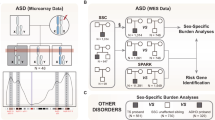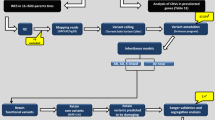Abstract
Attention-deficit hyperactivity disorder (ADHD) is the most common childhood psychiatric disorder, affecting 5–10% of school-age children. Although the biological basis of this disorder is unknown, twin and family studies provide strong evidence that ADHD has a genetic basis involving multiple genes. A previous study found an association between ADHD and two polymorphisms in the 3′ untranslated region (UTR) of SNAP-25, a gene encoding a synaptic vesicle docking protein known to play a role in the hyperactivity observed in the Coloboma mouse strain. In this paper, we test biased transmission of the 3′ UTR SNAP-25 haplotype using a larger ADHD sample of 113 families with 207 affected children. Using the transmission disequilibrium test (TDT), we found a trend consistent with biased transmission of the TC haplotype of SNAP-25 in all transmissions and detected a significant distortion (P=0.027) when paternal transmissions were evaluated.
This is a preview of subscription content, access via your institution
Access options
Subscribe to this journal
Receive 12 print issues and online access
$259.00 per year
only $21.58 per issue
Buy this article
- Purchase on Springer Link
- Instant access to full article PDF
Prices may be subject to local taxes which are calculated during checkout
Similar content being viewed by others
References
Cantwell DP . Attention deficit disorder: a review of the past 10 years. J Am Acad Child Adolesc Psychiatry 1996; 35: 978–987.
Taylor E, Chadwick O, Heptinstall E, Danckaerts M . Hyperactivity and conduct problems as risk factors for adolescent development. J Am Acad Child Adolesc Psychiatry 1996; 35: 1213–1226.
Faraone SV, Biederman J, Spencer T, Wilens T, Seidman LJ, Mick E et al. Attention-deficit/hyperactivity disorder in adults: an overview. Biol Psychiatry 2000; 48: 9–20.
Schubiner H, Tzelepis A, Milberger S, Lockhart N, Kruger M, Kelley BJ et al. Prevalence of attention-deficit/hyperactivity disorder and conduct disorder among substance abusers. J Clin Psychiatry 2000; 61: 244–251.
Eaves LJ, Silberg JL, Meyer JM, Maes HH, Simonoff E, Pickles A et al. Genetics and developmental psychopathology: 2. The main effects of genes and environment on behavioral problems in the Virginia Twin Study of Adolescent Behavioral Development. J Child Psychol Psychiatry 1997; 38: 965–980.
Faraone SVB . Neurobiology of attention-deficit hyperactivity disorder. Biol Psychiatry 1998; 44: 951–958.
Smalley SL . Genetic influences in childhood-onset psychiatric disorders: autism and attention-deficit/hyperactivity disorder. Am J Hum Genet 1997; 60: 1276–1282.
Smalley SL, McGough JJ, Del'Homme M, NewDelman J, Gordon E, Kim T et al. Familial clustering of symptoms and disruptive behaviors in multiplex families with attention-deficit/hyperactivity disorder. J Am Acad Child Adolesc Psychiatry 2000; 39: 1135–1143.
Cook Jr EH, Stein MA, Krasowski MD, Cox NJ, Olkon DM, Kieffer JE et al. Association of attention-deficit disorder and the dopamine transporter gene. Am J Hum Genet 1995; 56: 993–998.
Comings DE, Chen C, Wu S, Muhleman D . Association of the androgen receptor gene (AR) with ADHD and conduct disorder. Neuroreport 1999; 10: 1589–1592.
Swanson JM, Sunohara GA, Kennedy JL, Regino R, Fineberg E, Wigal T et al. Association of the dopamine receptor D4 (DRD4) gene with a refined phenotype of attention deficit hyperactivity disorder (ADHD): a family-based approach. Mol Psychiatry 1998; 3: 38–41.
Smalley SL, Bailey JN, Palmer CG, Cantwell DP, McGough JJ, Del'Homme MA et al. Evidence that the dopamine D4 receptor is a susceptibility gene in attention deficit hyperactivity disorder [see comments] [published erratum appears in Mol Psychiatry 1999 Jan;4(1): 100]. Mol Psychiatry 1998; 3: 427–430.
Eisenberg J, Mei-Tal G, Steinberg A, Tartakovsky E, Zohar A, Gritsenko I et al. Haplotype relative risk study of catechol-O-methyltransferase (COMT) and attention deficit hyperactivity disorder (ADHD): association of the high-enzyme activity Val allele with ADHD impulsive–hyperactive phenotype. Am J Med Genet 1999; 88: 497–502.
Eisenberg J, Zohar A, Mei-Tal G, Steinberg A, Tartakovsky E, Gritsenko I et al. A haplotype relative risk study of the dopamine D4 receptor (DRD4) exon III repeat polymorphism and attention deficit hyperactivity disorder (ADHD). Am J Med Genet 2000; 96: 258–261.
Kotler M, Manor I, Sever Y, Eisenberg J, Cohen H, Ebstein RP et al. Failure to replicate an excess of the long dopamine D4 exon III repeat polymorphism in ADHD in a family-based study. Am J Med Genet 2000; 96: 278–281.
Hawi Z, McCarron M, Kirley A, Daly G, Fitzgerald M, Gill M . No association of the dopamine DRD4 receptor (DRD4) gene polymorphism with attention deficit hyperactivity disorder (ADHD) in the Irish population. Am J Med Genet 2000; 96: 268–272.
Palmer CG, Bailey JN, Ramsey C, Cantwell D, Sinsheimer JS, Del'Homme M et al. No evidence of linkage or linkage disequilibrium between DAT1 and attention deficit hyperactivity disorder in a large sample. Psychiatr Genet 1999; 9: 157–160.
Manor I, Kotler M, Sever Y, Eisenberg J, Cohen H, Ebstein RP et al. Failure to replicate an association between the catechol-O- methyltransferase polymorphism and attention deficit hyperactivity disorder in a second, independently recruited Israeli cohort. Am J Med Genet 2000; 96: 858–860.
Hess EJ, Jinnah HA, Kozak CA, Wilson MC . Spontaneous loco-motor hyperactivity in a mouse mutant with a deletion including the Snap gene on Chromosome 2. J Neurosci 1992; 12: 2865–2874.
Wilson MC . Coloboma mouse mutant as an animal model of hyperkinesis and attention deficit hyperactivity disorder. Neurosci Biobehav Rev 2000; 24: 51–57.
Steffensen SC, Henriksen SJ, Wilson MC . Transgenic rescue of SNAP-25 restores dopamine-modulated synaptic transmission in the coloboma mutant. Brain Res 1999; 847: 186–195.
Hess EJ, Rogan PK, Domoto M, Tinker DE, Ladda RL, Ramer JC . Absence of linkage of apparently single gene mediated ADHD with the human syntenic region of the mouse mutant Coloboma. Am J Med Genet 1995; 60: 573–579.
Barr CL, Feng Y, Wigg K, Bloom S, Roberts W, Malone M et al. Identification of DNA variants in the SNAP-25 gene and linkage study of these polymorphisms and attention-deficit hyperactivity disorder. Mol Psychiatry 2000; 5: 405–409.
Kaufman JBB, Brent D, Rao U . Schedule for affective disorders and schizophrenia for school aged children (6–18 years)—present and lifetime version (K-SADS-PL): initial reliability and validity data. J Am Acad Child Adolesc Psychiatry 1997; 36: 980–988.
Swanson J . SNAP-IV Scale. Irvine: University of California Child Development Center, 1995.
Achenbach T . Empirically Based Taxonomy: How to Use Syndromes and Profile Types Derived From the CBCL From 4 to 18 TRF and WSR. Burlington: Department of Psychiatry, University of Vermont; 1993.
Chen X, Levine L, Kwok PY . Fluorescence polarization in homogeneous nucleic acid analysis. Genome Res 1999; 9: 492–498.
Hinds DA, Risch N . The ASPEX package: affected sib-pair exclusion mapping. ftp://lahmed.stanford/edu/pub/aspex.1996.
Spielman RS, McGinnis RE, Ewens WJ . Transmission test for linkage disequilibrium: the insulin gene region and insulin-dependent diabetes mellitus (IDDM). Am J Hum Genet 1993; 52: 506–516.
Lange K . Mathematical and Statistical Methods for Genetic Analysis, 1st edn. New York: Springer, 1997.
Greally JM, State MW . Genetics of childhood disorders: XIII, Genomic imprinting: the indelible mark of the gamete. J Am Acad Child Adolesc Psychiatry 2000; 39: 532–535.
A generalization of the transmission/disequilibrium test for uncertain-haplotype transmission. Am J Hum Genet 1999; 65: 1170–1177.
Risch N, Merikangas K . The future of genetic studies of complex diseases. Science 1996; 273: 1516–1517.
Fisher SE, Francks C, McCracken JT, McGough JJ, Marlow AJ, MacPhie L et al. A genome-wide scan for loci involved in attention-deficit/hyperactivity disorder (ADHD). Am J Hum Genet, 2002; 70: 1183–1196.
Acknowledgements
We thank LJL Biosystems for a generous loan of their LJL Analyst HT instrument for fluorescence polarization measurement. We thank Lori Crawford for genomic DNA sample preparations, assistance in developing the genotyping assay, and critical assessment of this manuscript. We thank all the families that participated in the research. We thank Tae Kim, Laura Combs, Melissa Del Homme and Leah Pressman for their work in data collection. VK was supported by the USPHS National Research Service Award GM07104. The work was supported by NIH Grant RO1 MH58277 to SLS and by UC-BioSTAR Grant B990817 to SFN.
Author information
Authors and Affiliations
Corresponding author
Rights and permissions
About this article
Cite this article
Kustanovich, V., Merriman, B., McGough, J. et al. Biased paternal transmission of SNAP-25 risk alleles in attention-deficit hyperactivity disorder. Mol Psychiatry 8, 309–315 (2003). https://doi.org/10.1038/sj.mp.4001247
Received:
Revised:
Accepted:
Published:
Issue Date:
DOI: https://doi.org/10.1038/sj.mp.4001247
Keywords
This article is cited by
-
Syntaxin-1a and SNAP-25 expression level is increased in the blood samples of ischemic stroke patients
Scientific Reports (2022)
-
The Association of SNAP25 Gene Polymorphisms in Attention Deficit/Hyperactivity Disorder: a Systematic Review and Meta-Analysis
Molecular Neurobiology (2017)
-
Synaptosome-Associated Protein 25 (SNAP25) Gene Association Analysis Revealed Risk Variants for ASD, in Iranian Population
Journal of Molecular Neuroscience (2017)
-
Expanding the toolbox of ADHD genetics. How can we make sense of parent of origin effects in ADHD and related behavioral phenotypes?
Behavioral and Brain Functions (2015)
-
Evidence of association between SNAP25 gene and attention deficit hyperactivity disorder in a Latin American sample
ADHD Attention Deficit and Hyperactivity Disorders (2014)



